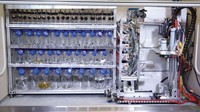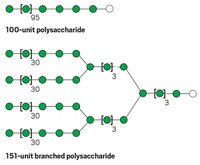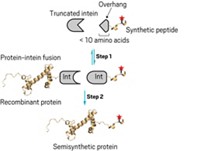Advertisement
Grab your lab coat. Let's get started
Welcome!
Welcome!
Create an account below to get 6 C&EN articles per month, receive newsletters and more - all free.
It seems this is your first time logging in online. Please enter the following information to continue.
As an ACS member you automatically get access to this site. All we need is few more details to create your reading experience.
Not you? Sign in with a different account.
Not you? Sign in with a different account.
ERROR 1
ERROR 1
ERROR 2
ERROR 2
ERROR 2
ERROR 2
ERROR 2
Password and Confirm password must match.
If you have an ACS member number, please enter it here so we can link this account to your membership. (optional)
ERROR 2
ACS values your privacy. By submitting your information, you are gaining access to C&EN and subscribing to our weekly newsletter. We use the information you provide to make your reading experience better, and we will never sell your data to third party members.
Biological Chemistry
Microwaves Beam Into Biosciences
Heating technology proves useful in proteomics and synthesis of peptides, proteins, and carbohydrates
by Amanda Yarnell
May 21, 2007
| A version of this story appeared in
Volume 85, Issue 21

FAR FROM THE WORLD of leftovers and frozen dinners, microwaves have become a fixture in synthetic organic chemistry labs. Organic chemists have come to treasure microwaves because in many cases, using them to inject energy into a reaction mixture improves product yields and speeds up reaction rates. That's why many chemists wouldn't think of doing certain reactions, particularly those that involve highly polar reagents or metal catalysts, any other way.
Spurred by the charms of using microwaves for making organic molecules, chemists have begun to test whether they can use microwave technology to eke more value out of biologically relevant processes. Michael J. Collins, president and chief executive officer of Matthews, N.C.-based scientific microwave instrument manufacturer CEM, is bullish about the possibilities. "Microwaves' impact on biochemistry and biology will far eclipse their effect on chemical synthesis," he predicted at the firm's fifth International Microwaves in Chemistry Conference, held last month at Imperial College London.
Indeed, a distinct biological flavor was in evidence at that conference. "Microwaves show a lot of potential for accelerating the biosciences," noted microwave aficionado Nicholas Leadbeater of the University of Connecticut, who recently penned a review on the subject with Jonathan M. Collins, bioscience product manager at CEM (Org. Biomol. Chem. 2007, 5, 1141). His fellow speakers illustrated his point by describing how microwaves are being used to improve solid-phase peptide synthesis, to ease the chemical modification of proteins, to make automated carbohydrate synthesis a reality, and to accelerate proteomic analyses.
In traditional automated peptide synthesizers, amino acids are added sequentially to a growing peptide chain immobilized on a solid support, such as a polymer bead. The chain is extended through repeated cycles of coupling and deprotection: The dangling N-terminal amine of a solid-supported peptide is coupled to an amino acid featuring a protected N-terminal amine. The deprotection step exposes the extended peptide's N-terminal amine, to which further amino acids can be added. Maximizing the yield of each cycle of coupling and deprotection is crucial to achieve high yields of the desired peptide.
The use of microwave heating in automated peptide synthesis can markedly decrease synthesis times and improve product yields. "With a microwave-assisted peptide synthesizer, we've been able to make peptides we can't make with other machines," said Benjamin G. Davis, a chemistry professor at the University of Oxford and founder of Oxford-based GlycoForm, a biotechnology company. For example, his team has used the instrument to make large, thioester-tipped fragments of immunoglobulins that they can then stitch together via microwave-assisted chemical ligation for potential use as therapeutics.
IN ADDITION to shortening the time required to complete each cycle of coupling and deprotection, the use of microwave energy can also improve peptide yields by preventing unwanted aggregation, Michael Collins told C&EN. The rapid injection of energy delivered by the microwaves keeps the growing peptide chain from relaxing and folding up on itself or aggregating with neighboring chains, he explained.

Researchers also are using microwave energy to stitch preassembled peptides together. Steve Marsden, a reader in the school of chemistry at the University of Leeds, in England, reported that microwave energy accelerates the preparation of peptide macrocycles with ring-closing olefin metathesis reactions. His team makes olefin-tipped peptides on a solid support, then cyclizes them via microwave-promoted ring-closing metathesis. The resulting peptide macrocycles are the largest yet prepared by way of this metathesis pathway, he said. What's more, he added, "this challenging cyclization could only be efficiently achieved under microwave irradiation."
Stephen Caddick, a professor of chemistry and chemical biology at University College London, described another microwave-assisted metathesis method, this one for linking peptide and peptoid fragments featuring terminal olefins (Org. Biomol. Chem. 2007, 5, 1025). Microwave heating dramatically reduces the time required to carry out these stereoselective reactions and greatly improves yields, Caddick reported. He hopes to use the method to make peptides or proteins bearing backbone modifications.
Microwave energy can also facilitate site-specific modification of proteins, according to Davis. His lab recently rolled out a method by which two different small molecules can be installed at two different, predetermined sites on the same protein (Nature 2007, 446, 1105; C&EN, April 30, page 6). The method relies on microwaves to drive one of the conjugation reactions to completion. Davis also described his group's unpublished efforts to use olefin cross-metathesis to install a sugar at a specific, predetermined site on a protein. "This reaction requires microwave energy to work," he said.
Like automated peptide synthesis, the automated synthesis of complex sugar chains may someday benefit from the application of microwave energy, according to work presented by Nicola L. Pohl, an associate professor of chemistry at Iowa State University. Her lab is developing an automated route to carbohydrate synthesis in which the growing sugar chain bears a fluoropolymer tail for easy isolation. Pohl reported that the use of microwave energy accelerates both the synthesis of some of the sugar building blocks and the necessary deprotection steps between the chain-building steps.
Researchers are ushering microwaves into the proteomics field as well. Jennie Lill, a scientist in Genentech's microchemistry and proteomics facility in South San Francisco, described her team's systematic evaluation of the utility of microwave energy in characterizing proteins, including some of the firm's tough-to-analyze monoclonal antibody-based drugs. For example, they've found that microwave energy makes it much easier to strip sugars from monoclonal antibodies for molecular weight analysis—cutting typical reaction times from more than 24 hours to less than two hours. Microwave energy also speeds N-terminal sequencing and quantitation of antibody samples, Lill reported.
With microwaves finding broader use across the chemical and biological sciences, more than 250 scientists turned out for this year's microwave meeting—far more than the early adopters who assembled five years ago at the first edition of this conference series, Leadbeater noted. The next meeting, which Michael Collins expects will reflect further growth in the use of microwave energy in the biosciences, will be held in Cambridge, Mass., in 2008.





Join the conversation
Contact the reporter
Submit a Letter to the Editor for publication
Engage with us on Twitter